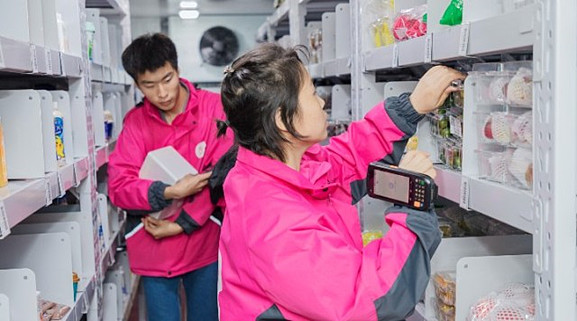
Speedy delivery is the name of the game for supermarket retailers all over the world right now, as major chains invest in micro fulfilment centres and explore dark stores in an effort to keep up with customers’ rising expectations during the pandemic.
But back in 2015, Chinese e-commerce grocery retailer Missfresh had already launched its distributed mini warehouses (DMWs) to help deliver groceries to customers within 30 minutes in 15 cities across the country. The company has gained a wide range of shareholders over the years including Tiger Global Management and Goldman Sachs leading up to its IPO. In June, the brand went public on the NASDAQ.
Here, we chat with Missfresh about how the DMWs operate, how it’s digitalising fresh markets and its plans for the future.
Can you explain a bit about how Missfresh has grown in popularity since launching in 2014?
Missfresh was the first to invent the distributed mini warehouse (DMW) business model in China in 2015, before any other player in the on-demand DMW industry. Our DMW model offers an innovative solution to the growing consumer demand for high-quality product offerings and timely delivery, leveraging technological innovation.
In contrast to traditional e-commerce platforms, our DMW model offers a more convenient experience, fresher products, and better-quality control along the supply chain. We have close collaboration with upstream supply chain partners and over 80 per cent of our products are directly procured from their places of origin. We also own our user acquisition channels and after-sales services, which ensures the best products and services being delivered to our customers.
Our DMW operation is backed by our proprietary technology platform which enhances the automation level and efficiency of the entire operation process by using data analytics and AI to replace human decisions in areas such as inventory replenishment, procurement and turnover management.
With an innovative business model and a superior shopping experience provided to our customers, we appeal to a new generation of consumers who are willing to pay for high-quality and convenience in grocery shopping.
In 2020, our market share of China’s on-demand DMW retail industry in terms of GMV was 28 per cent, ranked first in North China, according to iResearch. We also ranked the highest by satisfaction rate of consumers compared to our competitors, according to a survey conducted by iResearch in February 2021.

How big is Missfresh now? How many distributed mini warehouses (DMW) are across China?
Missfresh generated RMB 6.1 billion revenue ($943.7 million) in 2020 and provided on-demand service to an accumulated number of 31 million customers in China by 2020. In 2020, our market share of China’s on-demand DMW retail industry in terms of GMV was 28 per cent, ranked first in North China, according to iResearch. By the end of June 2021, Missfresh operated 625 mini-warehouses in 16 cities in China.
In what ways does your business model facilitate 30-minute delivery?
We set up DMWs, which are located near residential communities or office buildings. These are small and medium-sized storage and distribution centre, equipped with multiple temperature zones for fresh food processing such as refrigeration, freezing, and reheating. Each DMW is about 300-square-metres in size on average and stores more than 4,300 SKUs, serving neighbouring communities within three kilometres. After we procure the products directly from their places of origin, the products are transported to our regional quality control centre and then to our mini warehouses by cold-chain enabled logistics.
Users can place orders via the Missfresh mobile app and e-commerce platforms which assign online orders to the nearest DMW through its intelligent system and the products are delivered to customers in 37 minutes on average, which greatly improves the delivery timeliness and saves last-mile delivery costs.
How has Missfresh ‘digitised all aspects of neighborhood retail’?
Missfresh has three building blocks for its business, including on-demand DMW retail, intelligent fresh markets and retail cloud business.
In first tier and second tier cities, we focus on our DMW model to provide on-demand service to high value customers who require quality products and convenient shopping experience. Our pioneering DMW business model greatly improves the efficiency of the long value chain in the retail industry by leveraging our proprietary Retail AI Network technology platform, which consists of smart supply chain, smart logistics and smart sales and marketing.
In lower tier cities, we initiated our Intelligent Fresh Market business to digitalise the operation of traditional fresh markets. We also empower the local retailers by offering our retail cloud service to help them accelerate digital transformation and jumpstart their online business operation in a more efficient way.
Therefore, with a combination of three businesses, Missfresh targets the mainstream shopping channels for mainstream consumers in China. We are able to empower the neighbourhood retail market through our technological capabilities and further seize the market opportunities in the digitalisation of the industry.

Inside one of Missfresh’s distributed mini warehouses in China. Image: Supplied.
Can you explain a bit about the Missfresh supplier network and how that impacts the product range?
We offer around 4,000 SKUs of quality products to our customers, including fresh produce and fast-moving consumer goods. We focus our effort on directly purchased goods from manufacturers and producers. In 2020, over 80 per cent of the goods and over 93 per cent of fresh produce we offered were directly procured from producers.
Our direct procurement effort is led by a seasoned merchandising team of around 300 employees. We impose a strict screening process for potential suppliers who wish to work with us. We focus on standardised criteria for the selection and evaluation of our suppliers on the basis of product quality, reputation, scale of production, price and ability to meet our delivery schedule. In 2020, our procurement specialists supervised over 2,300 suppliers.
What are Intelligent Fresh Markets and how do they work?
In China, fresh markets are where most neighborhood retail and shopping still take place. They are deeply integrated in Chinese society, represent a large portion of economic activity, and are generally an irreplaceable facet of people’s lives. However, this sector requires digitalisation to become more efficient and to keep up with technological advancements and properly meet the changing needs and preferences of modern consumers.
In order to bring China’s fresh markets into the digital age, Missfresh has pioneered the Intelligent Fresh Market business model, bringing cutting-edge technology to an industry that has huge room for transformation.
Leveraging the core capabilities developed through our self-operated on-demand DMW retail business, we launched our Intelligent Fresh Market business in late 2020. Through this business model, we standardise and transform fresh markets into smart fresh malls by:
(i) reconfiguring the market floor plan, optimising the merchants mix and introducing new service offerings;
(ii) providing merchants with a SaaS-based service package including electronic payment, online marketing, CRM tools and business planning; and
(iii) through our value-added services, enabling merchants at our intelligent fresh markets to convert and manage offline private traffic to our platforms and to realise additional monetisation.
By the end of June 2021, we had entered into contracts to operate 58 fresh markets in 15 cities in China and have started to operate 34 of them.
How has the micro-fulfillment and local delivery trend developed in China over the past five to seven years?
The on-demand DMW retail market is one of the fastest growing segments in the online neighbourhood retail market.
By delivering premium products and service quality, on-demand DMW retail companies can best meet the demand of a new generation of consumers with increasing spending power and willingness to pay for quality and convenience in grocery shopping representing massive potential in lifetime value. They are expected to be the key driving factor in the growth of the neighbourhood retail industry and represent an increasing contribution to the overall market size.
The market size of China’s on-demand DMW retail industry was $247.5 million (RMB 1.6 billion) in 2016, reached $5.2 billion (RMB 33.7 billion) in 2020, and is expected to grow at a CAGR of 59.5 per cent between 2020 and 2023. By 2025, the market is expected to reach $47.5 billion (RMB 306.8 billion).
(Source:Inside Retail)